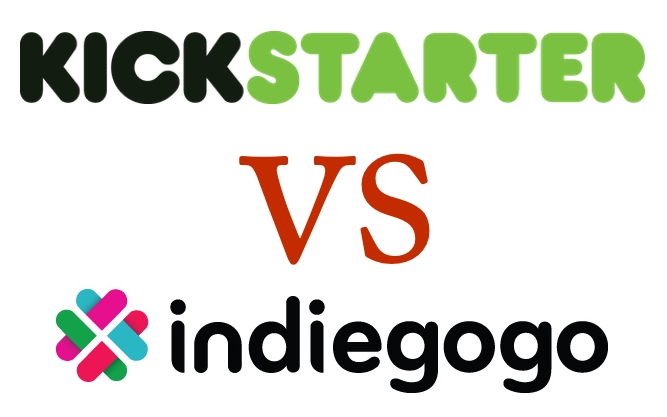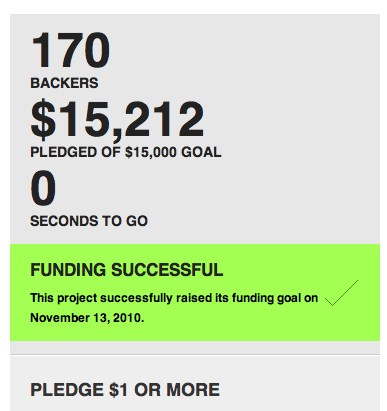People often ask me which crowd-funding platform is the best. My response is, aside from the site guidelines and ease of use, it really doesn’t matter.
Over the past couple years, I have spent a lot of time trying to figure out what successful crowd-funding campaigns have in common. Through this process I’ve been able to identify five factors which I believe are vital when trying to raise money from the crowd. While these factors come from looking at hundreds of Kickstarter projects, I believe that they relate to just about any crowd-funding endeavor.
Spoiler Alert: They have nothing to do with which platform you choose.
A brief History of Crowd-funding
Before we talk about specific factors, lets look at the history of crowd-funding. Even though sites like Kickstarter and Indiegogo have become popular in the past couple years, online crowd-funding has actually been around for almost 15 years.

In 1997 a British rock group named Marillion was able to raise money from its supporters to go on tour. Ten years later, in October of 2007 Radiohead released their seventh album In Rainbows on their own website, allowing people to pay whatever they wanted.
Recently comedian Luis CK wrote about producing and releasing his own comedy special. After he recorded the special he released it online for $5. It has been downloaded over 500,000 times, earning him well over a million dollars.
What is interesting about these examples is that they were successful even though the creators did not use a site like Kickstarter or Indiegogo. Each creator used the internet to leverage their existing fan base. You might be thinking, “I’m not like them, I don’t have thousands of fans.” That’s the point I will be trying to make with this post.
The success of your project has little to do with which platform or site you choose, and everything to do with your ability to reach an audience that cares, engage them in a compelling way, and offer them something of value.
What I’ve learned:
- Audience – You must target a specific audience with your project.
- Reach – You must be able to reach enough of that audience to meet your goals.
- Engagement – You must engage that audience with a unique idea or a compelling story.
- Offer – You must offer that audience a product or experience of value.
- Explanation – You must make the description of the project simple enough that someone else can explain it.
Bonus:
- My crazy prediction – My prediction about the future of crowd-funding.
- Take it slow – It’s taken me a year to write this, so don’t try and process it all at once.
Audience
Audience is by far the most important part of getting a project funded online. The reason that people like Seth Godin, Amanda Palmer, and Louis CK have such an “easy time” getting funded is that they have spent years developing and cultivating an audience. When they launch a project they have a group of people who love their work and want to support them. It may seem obvious, but most people fail to realize this.
When you don’t have an audience of your own, you must be trying to identify one. Making sure that the project resonates with them is incredibly important. Projects are backed by people who believe in what you are trying to do, not random strangers online.
Built-in Audience
Crowd-funding works best when you have a build-in audience. But how do you know if you have an audience or not? If you have to ask, you don’t have one. But just in case you were wondering, here are some examples.
- A following (Fan base, Community)
- A permission asset (Blog, Newsletter, Podcast, or Video channel)
- Proven track record (Existing customers, Industry experience)
- An extensive personal network (Facebook, LinkedIn, Address book)
Most “built-in audiences” take a long time to build up. You can not start this process two weeks before launch. It can take months or years to build a sizable audience that is passionate about your work. A great resource for how to build such an audience is Gary Vaynerchuk’s, Crush It.
Personal networks act similarly to a built-in audience but they are usually limited in size and resources. That is why having a real, sizable, built-in audience is such a powerful asset. You have a group of people who are interest in your type of project, trust you, and that you can easily reach.
Exercise 1: Think about all the people you could possibly reach out to (family, friends, co-workers, church members, etc.) Say it’s about 500 people and of those, 10% back your project. 10% is actually a high conversion rate when selling online but we will use it for simplicity. 10% of 500 is 50. If 50 people gave you $70 (the average pledge on Kickstarter) would you hit your goal?
What if you don’t have a built-in audience?
Creators without a built-in audience must actively look for communities or tribes where their message will resonate. I’ll talk about how to do this in the Reach section. But, before you reach out to people you need to think about who they are and why they would like your project. Who are the people that are actually going to pay money to see your project come to life.
To often people don’t spend enough time thinking about this and they struggle to get enough backers to reach their goal. One of the biggest misconceptions of crowd-funding is that the “crowd” will just show up and fund the project. From my research (and personal experience) this is just not the case. It is completely up to the project creator to bring the audience to the project.
Chances are you already have a group or several groups of people in mind. They might like jazz music or tech products or SiFi films but your probably need to get more specific then that. Try to define your audience by their world view not by there age sex or location. What do they believe in? What do they wear? Where do they hangout?
Keep these groups in mind while you put together your campaign. It might be your project, but they are the ones who will make it happen.
Exercise 2: Try making a customer archetype, a profile of a person that is a member of the audience you want to reach. You can make the person up or base it off of someone you know. This will help you get out of your head and into theirs, so you can view the project from their perspective. You can constantly ask yourself, would “Joe” or “Susan” like this?
What about the Kickstarter/Indiegogo audience?
You might be wondering about the existing audience on whatever crowd-funding platform you chose. Won’t they help fund your project? Maybe, but probably not to the extent you are hoping.
In the Kickstarter project to write this guide I got several backers who also backed multiple projects on Kickstarter. For the most part they only gave my project a couple of dollars. When I looked into their profiles I saw that some people had backed as many as 50 projects or more. (One even backed 170! ) So if people are backing a lot of projects, they probably aren’t spending a lot of money.
Another example of the limited impact of site specific audiences is a project that my friend Cedric Victor did. His project was a staff pick and ended up on the project page of Kickstarter.com. The result was $240 in sales. Not too bad for his goal of $3000, but for larger projects that’s barely a drop in the bucket.
Reach
Once you have defined who you think is going to back your project, you need to figure our how you are going to reach them. It’s tempting to think that the internet will always find and promote the best material but from my experience I don’t think that is the case. As I’ve tried to point out, it is up to the project creator to bring the audience to their project.
Reach is about two things, how many, and how much. How many people can you reach and how much do they trust you?
How many people can you reach?
The best way to explain this concept is with an example. Using the numbers from exercise 1, when 50 people back a project, at $70 each, the creator raises $3500. In order to get $3500 from 50 people they had to reach out to 500 people.
Now, let’s say your funding goal is $15,000. To figure out the reach needed, divide the goal by the average pledge ($15,000/$70 = 200 backers), which gives you the backer count. Then divide the backer count by our optimistically high 10% conversion rate (200 backers/0.1 CR = 2,000 views) and you get the number of views needed to hit a $15,000 funding goal.
This is where things get difficult. The larger your funding goal, the more people you will have to reach. With a goal of $50,000 you might have to reach as many as 6,700 people or more. Since the average person can only reach a small group of people (family, friends, or current customers) this might explain why there seems to be a limit, around $20,000, to how much most projects raise.
So how do you get a project out to more than just a hand full of people? There are a couple of ways to do this:
- Pitching blogs, websites, and news outlets
- Pitching people with existing audiences (Influencers)
- Pitching communities or groups of people
When reaching out to people and groups you don’t know there is always a risk that they won’t embrace your project. That can be a scary but an important part of the process. My advice: If you aren’t getting traction with your outreach efforts then back off. After awhile even the most well intentioned outreach becomes spam.
Some great resources on generating press for your project are:
How much do they trust you?
I want to point out that it’s not just about how many people you can get to see your project link. Trust is a huge part of the equation. This is another reason why having a build-in audience is so powerful. They already know you and trust you.
It’s very hard to get people who don’t know you, or haven’t been exposed to your work, to back you. Besides the financial risk, there is also an “emotional” risk. People want to back winners and since they don’t know you, they are skeptical that you can deliver.
One way of combating this problem is by having someone, who is trusted by the audience you are trying to reach, share your project. This provides social proof and minimizes the perceived risk of backing you. However, most influencers and people with large audiences aren’t just going to talk about your project because you ask them too. They also need to know you and trust you.
Tip: Build as many meaningful relationships as you can before you launch, and then ask them if they will help you get the word out.
Engagement
To get the audience interested in your project you must engage them with a unique idea, or tell a compelling story. Projects that represent unique ideas are much easier to market, but they are also harder to replicate. Projects that tell a compelling story require a certain level of skill, and experience with storytelling and must meet the expectations of the audience you’re trying to reach. It’s important to know which type of engagement you are going to use to market your project.
Unique Idea

From The Million Dollar Homepage, to One Red Paperclip, to the countless memes created every day, the Internet loves unique and quirky ideas. The trouble is, it’s hard to create one of these on purpose. The idea has to be truly unique and represent something that has never been done online before. However, if a project does fall into this category it will have a much easier time spreading online. Some crowd-funding examples are Detroit Needs A Statue of Robocop! or the OUYA: A New Kind of Video Game Console. Since most projects to not represent truly unique ideas, you should focus on telling a compelling story.
Compelling Story
Telling a good story about your project can make all the difference in the world. What makes it hard, is that not everyone has experience with telling a compelling story. If you haven’t had experience with writing copy or creating online videos, then it would be beneficial to find someone who has. Let them help you highlight the most important aspects of your project.
Tip: No matter what type of engagement you choose, you want to make sure that it resonates with the audience you are trying to reach. Share your project with some people from the audience before you launch to get their feedback. If they get really excited, you are on the right track. If not, you might need to rework your pitch before launching.
Offer
When someone backs your project you are offering them a product or an experience. How can you tell the difference? Unless you have a working prototype, that you can show on camera, then you are offering an experience. The difference is subtle but important.
When you are offering a product people are usually backing you to get that product in it’s final form. They have a different set of expectations then someone who is backing an experience. When you are offering an experience people are less concerned with the final product and might be backing the project just to support you.
It’s also important to note that people do not consciously think about backing a product vs experience. Most of the time they are backing your project because of the story. However, as the project creator you need to be clear on what type of offer you are making, and then structure your project accordingly.
Product
I use the word product in a very broad sense. A CD, film or theatrical production could be a product. The main distinction between a product or experience is the prototype. A prototype could be anything such as album art, or scenes from the film, or video of your rehearsals. You just need something to show, in the project video, that you have done 80% to 90% of the work.
Many of the highest grossing crowd-funding campaigns have been for products with working prototypes that needed a little extra funding to be finished. In this scenario the crowd-funding site acts as a powerful pre-sale mechanism. Pebble: E-Paper Watch for iPhone and Android, The Present and Capture Camera Clip System are all wonderful examples of this.
Experience
If you don’t have a working prototype of your final product than you are offering an experience. People are really backing you because they want to support you, or your idea. They are less focused on getting the actual product. You should still deliver on your promise, but hopefully they will give you a little more leeway if things don’t go according to plan.
The limitation of experience based projects is they typically do not raise as much as product based projects. This is because there is more perceived risk when backing ideas in their initial stages. What if the project never gets finished? How do I know the project creators can actually do this? You should expect that most of your backers will be people who already have a relationship with you.
The mistake people make is thinking that projects without a working prototype will receive massive amounts of funding. Unless the project creator has a large built-in audience, this just isn’t the case. As long as you keep this limitation in mind and set your goals accordingly, you shouldn’t have a problem.
There are a ton of ways to make your project more fun and inclusive for backers. Christopher Lackey did an amazing job of this with his project Transreality. Want to be a character in the comic book? You can! Part of the fun of backing his project is the experience he created around the actual product. Creating amazing experiences requires a bit of creative thinking, but it’s one of the biggest untapped resources when trying to get funded.
Tip: Obviously there is a huge benefit to waiting until you have a working prototype to launch a project, but this creates a paradox. The more money you need to create a product, the longer you should wait to crowdfund. The way around this is to start with a really small project, or find alternative financing that will get you to a working prototype.
Explanation
You must make the description of the project simple enough that someone else can explain it. A critical aspect to a crowd-funding campaign is sharing the project. If someone cannot easily explain your project, it will have a much harder time spreading.
This does not mean your project has to be simple, but the explanation and description does. Make sure you spend a lot of time refining your pitch so that it is easy to understand. Share it with people and get their feedback. If they say “I don’t get it” then you need to keep working on it.
It may seem like a waste of time to put so much effort into the explanation, but you can avoid a lot of problems down the road. I typically spend the most amount of time getting the pitch and description right. Once you have a solid pitch the video, project description, and even the rewards fall right into place.
My crazy prediction
Most crowd-funding sites will not be around in the next five years. The same reason that the platform does not matter, is the same reason why these sites will not be around. It all comes down to audience.
The biggest factor to a the success of a crowd-funding campaign is having an audience or being able to reach and audience. The actual site that hosts the project really does not make that big of a difference. That is why I think most of the smaller crowd-funding sites are going to struggle.
People will launch on one of those sites, expecting that their will be a crowd of people waiting to back their project. When no one shows up they will give up or go somewhere else. And unless the crowd-funding site has a steady stream of successful projects it won’t be a feasible business model. The only way smaller sites can stay alive is by cultivating and maintaining a passionate audience that funds a few projects.
Take is slow
So I know there is a lot of information here. My advice is to sit with it and not try to use it all at once. Looking at the history of this post I realized that it has taken me nearly a year (Started Sept 24th, 2012) to write this. The writing process has been slow but it’s also taken me a while to be able to explain this information clearly.
Give yourself time to process it all. You should bookmark it, save it to Evernote, or whatever works for you but come back to as your work thorough your project. I hope it helps you make the best project that you can. I look forward to seeing you in the comments.
Nelson/Roberto







 I’m an average person who started a project and was fortunate enough to reach my goal. I have a blog but it’s small. I don’t have a popular podcast or web show. My project never got promoted by TechCrunch or any major blogs. I’m not a world famous product designer making cool iPod watches.
I’m an average person who started a project and was fortunate enough to reach my goal. I have a blog but it’s small. I don’t have a popular podcast or web show. My project never got promoted by TechCrunch or any major blogs. I’m not a world famous product designer making cool iPod watches.








 This experience was interesting for me because I talked about having a prototype in A Kickstarter’s Guide. I also talked about a soft launch and the importance of finding an audience. Basically everything that went wrong in my campaign I had written about in
This experience was interesting for me because I talked about having a prototype in A Kickstarter’s Guide. I also talked about a soft launch and the importance of finding an audience. Basically everything that went wrong in my campaign I had written about in